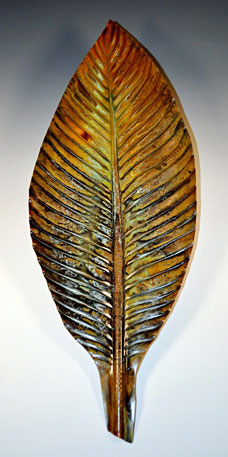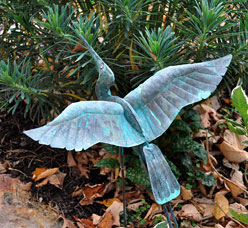Lost and Found in Copper
 Banana leaf copper sculpture.
Banana leaf copper sculpture. Photograph courtesy of Anne Jordan
Anne Jordan may have been able to map out geographical information for a living, as a longtime cartographer for the National Geospatial-Intelligence Agency, but she never could have predicted her future career as a copper artist.
"I've always been a bit creative, but it wasn't until I came upon copper that my creativity really took off," says Jordan.
The artist from northern Virginia had quit her job to stay home with her kids and, about four years ago, began tinkering with copper tooling and embossing on thin copper foil. "My neighbor gave me a laundry basket full of copper scraps left over from a roofing job," says Jordan. "That copper sat around for more than a year because it was so thick I couldn't figure out how to use it!"
Fortunately, she took a local coppersmithing class and learned the basics of cutting, annealing, hammering, and forming copper. Her talents also grew last year when she met fellow copper artist Ed Sharp of DRC Studios, who taught her how to braze-weld copper.
"That opened up a whole new 3-dimensional avenue for me," says Jordan.
She soon found herself creating everything from wall art and garden art, to bowls, trays, woven copper pieces and more. Her work is on display year-round at The Artists' Undertaking Gallery in Occoquan, Virginia.
"I haven't settled on one specialty area yet, and I'm not sure where exactly I'm headed, but I'm having a great time along the way," says Jordan.
Jordan loves experimenting and problem-solving with copper, especially appreciating the never-ending forms, textures, colors, and surprises the metal throws her way. Armed with a few of her favorite tools (a hatchet and her grandfather's old hammer), she pounds copper on the sidewalk for a unique pebbled texture. Tin snips are used to cut out the shape. The process also involves sanding; annealing the copper with a Mapp gas torch; chasing/repousse; coloring or finishing with a torch or chemicals like liver of sulfur or her compost pile for mottled browns; applying steel wool or a rotary tool for highlights; sealing it with beeswax or a clear-coat spray and, finally, brazing, if needed.
 Blue Heron Copper sculpture
Blue Heron Copper sculpture
Photograph courtesy of Anne Jordan
Jordan buys 20-ounce copper from a roofing supply company in 3-by-10-feet sheets, but her studio is also filled with unconventional metals like wheel rims, brake drums, heat grates, and a large composter bin piece she uses to sink the copper into. "I should probably have a bumper sticker that says 'Caution, I Brake for Rusted Metal,' since I've found these treasures while driving," she says.
"When I'm working with copper I can be in the studio for hours and it seems only like minutes," she continues. "The mistakes I make often turn out to be better than the perfect plan I had in mind. I think it's this forgiveness that fully ignited my creativity. I had fun and success making a simple copper dish from the first moment I touched a piece of copper in class. I didn't have to study and practice for years before completing something I was happy with, certainly a bonus for a busy mom."
Jordan loves the flexibility and artistic freedom copper brings to her work, with each piece as unique as the medium itself.
"As someone who loves nature's colors and textures, physical activity, and doesn't mind getting dirty, copper is the perfect medium," she adds. "There is also something special about hammering out a shape in metal. It's hard to describe, you just have to do it."
Resources:
Also in this Issue:
- Copperland: Decking The Halls with Copper
- Richard's Gill: Emotion and Form Through Copper
- Lost and Found in Copper
- Layers on Copper: The Cloisonné Jewelry of Julie Glassman
- Bronze Artifact Thought to be 1000 Years Old Discovered on Alaskan Penninsula
